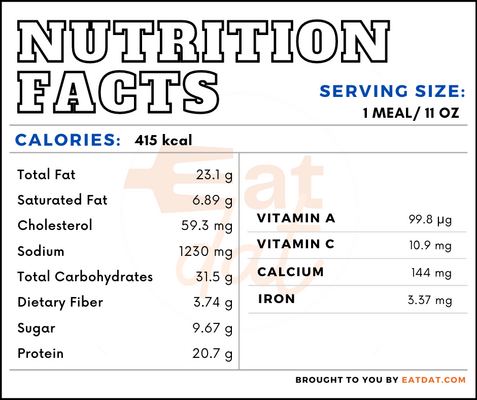
Meatloaf
What is Meatloaf?
Meatloaf is a meat-based dish of American origin. It is made with ground meat, eggs, breadcrumbs, and seasonings, and baked in the shape of a loaf. Beef is the most common meat used though lamb, pork, veal, venison, chicken, and seafood may also be used.
- Meatloaf mixes are sold readymade in the supermarket and may contain a mixture of beef, pork, and veal.
- Many countries have their own version of this dish.
Some of the most popular versions of this dish include:
- Pulpeta (Cuba)
- Gâteau de Viande (France)
- Sekana (Czech Republic)
- Pastel de Carne (Argentina)
- Bobotie (South Africa)
- Rolet Gosht (Iran)
Origin of meatloaf
The origin of meatloaf can be traced back to ancient Rome in 5th century AD. The first written record for this dish is from Apicius, a Roman cookbook that had a recipe for meat patties. However, it was the meat grinder that came about in the 1800s that made this dish popular. In the United States, the Great Depression increased this dish’s popularity. In the early days of the US, meatloaf was generally consumed for breakfast.
Nutrition
Nutritional profile for meatloaf (1 meal/11 oz):

Meatloaf is rich in essential micronutrients such as phosphorus, potassium, sodium, vitamin A, carotene, lycopene, and lutein. Additionally, it contains calcium, selenium, vitamin C, folate, cholic acid, choline, retinol, and fatty acids. Regular meat consumption can help in the absorption of zinc, vitamin B-12, and iron in the body. Also, it provides essential amino acids and biopeptides that are difficult to obtain from other sources.
However, high beef consumption can lead to diseases like colon cancer, inflammatory diseases such as atherosclerosis, diabetes, rheumatoid arthritis, macular degeneration, as well as infertility. If consumed in moderation, beef is a nutrient-dense food that increases the bioavailability of certain micronutrients.
Commercial production
The USA is the largest producer of beef in the world. Brazil, China, India, and Argentina, along with the US, account for 70 percent of the world’s beef production.
For preparing meatloaf, ground meat such as beef or pork or a mixture of different meats is required. The meat must have a higher fat content, so that it doesn’t fall apart. Eggs and breadcrumbs are used as binders. The seasoning often includes onions, garlic, herbs, and cheese. Milk or stock is used to increase the binding and ketchup is often used as a glaze.
Once cooked, meatloaf can be stored in the refrigerator for up to 4 days. Also, it can be frozen for a longer shelf life. This dish is sliced like bread and served hot.
Meatloaf recipes
This dish is eaten in different parts of the world and every country or region has its own version. Here are a few recipes:
- Classic Meatloaf
- Mozzarella Stuffed Meatloaf
- Chả Trứng Hấp
- Haggis
- Kiftet Batatta
- Klops
- Dast Peech-e Gusht
- Tandoori Lamb Meatloaf
- Noshidori
- Bulgogi
- Char Siu Glazed Meatloaf
- Bobotie
- Gehaktbrood
- Lihamureke
FDA regulations
The USDA regulates all meat products, including beef, which is defined as meat from full-grown cattle about 2 years old. The main cattle breeds used for producing beef are Angus, Hereford, Charolais, and Brahman. In the US, hormones are allowed to promote the growth of cattle. Grading of beef is voluntary and is graded as Prime, Choice, and Select. Pork is defined as the meat from hogs or domestic swine and is generally produced from young animals between 6 to 7 months old.
References
Frank Bruni and Jennifer Steinhauer, A History of Meatloaf, Long May It Reign, Excerpted from A Meatloaf in Every Oven: Two Chatty Cooks, One Iconic Dish and Dozens of Recipes – from Mom’s to Mario Batali’s, Bon Appétit, https://www.bonappetit.com/story/history-of-meatloaf
Carol Wilson, A Brief History of Eating Beef, Hereford Beef, https://www.herefordbeef.org.uk/blog/a-brief-history-of-eating-beef/
Klurfeld, David M. “What is the role of meat in a healthy diet?.” Animal frontiers : the review magazine of animal agriculture vol. 8,3 5-10. 7 Jul. 2018, doi:10.1093/af/vfy009, https://www.ncbi.nlm.nih.gov/pmc/articles/PMC7015455/
Alisson-Silva, Frederico et al. “Human risk of diseases associated with red meat intake: Analysis of current theories and proposed role for metabolic incorporation of a non-human sialic acid.” Molecular aspects of medicine vol. 51 (2016): 16-30. doi:10.1016/j.mam.2016.07.002, https://www.ncbi.nlm.nih.gov/pmc/articles/PMC5035214/
